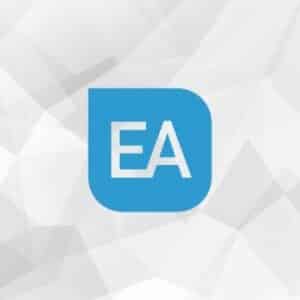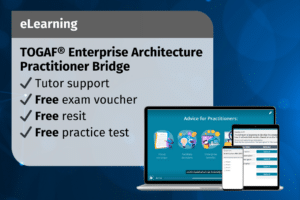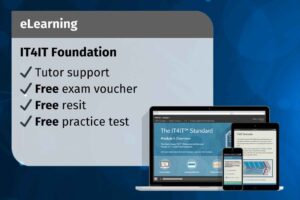Foundation Module 1: Introduction
- The TOGAF standard, Version 9.2 Foundation Workbook
- Why TOGAF Certification for People?
- The TOGAF Certification Program
Foundation Module 2: The Core Concepts of TOGAF 9
- Enterprise Architecture Background
- Interview with Allen Brown – CEO of The Open Group
- Architecture in the TOGAF Context?
- TOGAF Background
- Architecture Types
- TOGAF 9.2 Components
- What is the Value of TOGAF as an Architecture Framework
- What is an Architecture Framework?
- TOGAF Components
Foundation Module 3: The Architecture Development Method (ADM)
- Describe the main objectives of each phase
- Briefly explain the approach undertaken for each phase
- Briefly explain how Requirements Management fits into the ADM cycle
- Describe the nature of the Requirements Management process
- To briefly explain the contents of Part III of TOGAF 9.2
- The need for Architecture Principles and where they are used within TOGAF 9.2
- The standard template for Architecture Principles and what makes a good Architecture Principle
- What a Business Scenario is, its purpose, and explain where Business Scenarios are used within the ADM cycle
- The purpose of Gap Analysis and describe the Gap Analysis technique
- Explain the term interoperability, and understand the use of Interoperability Requirements within the TOGAF ADM
- To understand the Business Transformation Readiness program and where Business Transformation Readiness is used within the ADM
- To understand the characteristics of Risk Management and where Risk Management is used within the TOGAF ADM and to understand Capability-Based Planning
Foundation Module 4: Architecture Views, Viewpoints and Stakeholders
- To define and explain the concepts of Stakeholders, Concerns, Architecture Views, and Architecture Viewpoints
- To describe a simple example of an architecture viewpoint and view
- To discuss the relationship between stakeholders, concerns, architecture views, and architecture viewpoints
- To describe the architecture view creation process
Foundation Module 5: The Concept of Building Blocks
- To define what a building block is, and explain what makes a good building block
- To explain the distinction between Architecture Building Blocks and Solution Building Blocks
- To explain the use of building blocks in the ADM cycle
- To describe the characteristics of an Architecture Pattern
Foundation Module 6: The Key Deliverables of the ADM Cycle
- To explain the role of architecture deliverables across the ADM cycle
- To briefly explain the purpose of key TOGAF deliverables such as Architecture Building Blocks, Architecture Contract, Architecture Principles, Architecture Vision, Compliance Assessment, or Statement of Architecture Work
Foundation Module 7: The Enterprise Continuum
- To explain what the Enterprise Continuum is
- Describe how it is used in organising and developing an architecture
- To explain how the Enterprise Continuum promotes re-use of architecture artifacts
- Describe the constituents of the Enterprise Continuum
- To explain the purpose of the Enterprise Continuum
- To explain the purpose of the Architecture Continuum
- To list the stages of architecture evolution defined in the Architecture Continuum
- To explain the purpose of the Solutions Continuum
- To list the stages of architecture evolution defined in the Solutions Continuum
- To explain the relationship between the Enterprise Continuum and the TOGAF ADM
Foundation Module 8: The Architecture Repository
- To describe the Architecture Repository, and explain the relationship between the Enterprise Continuum and the Architecture Repository
- To describe the classes of information held in the Architecture Repository
- To list the three levels of the Architecture Landscape
- To explain the purpose of the Standards Information Base within the Architecture Repository
Foundation Module 9: The TOGAF Reference Models
- To explain the role of the TRM as a Foundation Architecture
- To describe at a high-level the main components of the TOGAF TRM
- To explain the basic concepts of the III-RM
- To explain the relationship of the III-RM to the concept of Boundary less Information Flow
Foundation Module 10: Architecture Governance and the ADM
- To explain the concept of Architecture Governance and explain why it is beneficial
- To describe the main components that make up an Architecture Governance framework
- To explain the need for establishment of an Architecture Board and list its responsibilities
- To explain the role of Architecture Contracts
- To explain the meaning of and need for Architecture Compliance
- To explain the purpose of Architecture Compliance Reviews and briefly describe the Architecture Compliance Review process
- To explain how the ADM can be used to establish an Architecture Capability
Certified Module 1: Preliminary Phase
- Understand the inputs to the phase and be able to explain the following key elements: Architecture Frameworks, Business principles, business goals, and business drivers
- Explain the influence of pre-existing architectural inputs on the phase
- Understand the steps and be able to: Describe how to establish an enterprise architecture team and organisation, identify and establish a set of Architecture Principles for a given scenario, discuss the appropriate considerations for tailoring the framework
- Understand the outputs and be able to explain the following key elements: Architecture Principles, Architecture Governance Framework, Request for Architecture Work
- Explain how Security Architecture influences this phase
Certified Module 2: Architecture Governance
- Explain how Architecture Governance fits within the ADM cycle
- Discuss the key success factors for putting Architecture Governance into practice
- Discuss the factors that should be considered when setting up an Architecture Board
- Explain how to operate an Architecture Board
Certified Module 3: Business Scenarios Techniques
- Describe the properties of a good Business Scenario
- Explain how to develop and validate a Business
Certified Module 4: Phase A: Architecture Vision
- Describe the typical contents of the Architecture Repository at this point
- Understand the steps and be able to describe how to identify stakeholders, their concerns, and business requirements. As well as being able to explain the purpose of a Business Transformation Readiness Assessment and describe the risk assessment approach taken in this phase
- Understand the outputs and be able to explain the following key elements including their purpose: Statement of Architecture Work, Capability Assessment, Architecture Vision and Communications Plan
- Explain the Security Architecture influences on this phase
Certified Module 5: Architecture Content Framework
- Explain the purpose of the Architecture Content Framework
- Describe the main components of the Content Metamodel
- Describe the relationship between the Architecture Content Framework and the TOGAF ADM
Certified Module 6: Stakeholder Management
- Describe the steps in developing a Stakeholder Map
- Describe the stakeholders and their concerns
- Use the example Stakeholder Map provided by the TOGAF Standard as a guideline to identify stakeholders
Certified Module 7: TOGAF Content Metamodel
- Describe the core metamodel concepts
- Explain the purpose of dividing the metamodel into core and extensions
- Describe the key concepts related to the core metamodel entities
Certified Module 8: Architecture Implementation Support Techniques
- Explain how to reconcile Interoperability Requirements with potential solutions
- Explain the factors that influence Business Transformation Readiness
- Explain how to determine requirements for risk assessments
- Explain how Capability-Based Planning is applied in an enterprise architecture context
Certified Module 9: Phase B: Business Architecture
- Understand the inputs to the phase and explain business principles, business goals, and business drivers
- Understand the steps and be able to: Describe three techniques for business modeling, explain the considerations for selecting reference models, viewpoints and tools, explain the technique of Gap Analysis
- Explain how building blocks are used in the development of the Business Architecture
- Understand the outputs and be able to explain the following key elements: Business Architecture components of the Architecture Definition Document, Business Architecture components of the Architecture Requirements Specification
- Explain the Security Architecture influences on this phase
Certified Module 10: Phase C: Information Systems Architectures – Data Architecture
- Explain the considerations for the implementation order of the Data and Application Architectures
- Understand the inputs to the phase and explain data principles
- Understand the steps and be able to explain the considerations for selecting reference models, viewpoints, and tools
- Understand the outputs and be able to explain the following key elements: Data Architecture components of the Architecture Definition Document, Data Architecture components of the Architecture Requirements Specification
- Explain the Security Architecture influences on this phase
Certified Module 11: Phase C: Information Systems Architectures – Application Architecture
- Understand the inputs to the phase and explain application principles
- Understand the steps and be able to explain the considerations for selecting reference models, viewpoints, and tools
- Understand the outputs and be able to explain the following key elements: Application Architecture components of the Architecture Definition Document, Application Architecture components of the Architecture Requirements Specification
- Explain the Security Architecture influences on this phase
Certified Module 12: TOGAF Foundation Architecture: The Technical Reference Model
- Explain the TRM graphic, including the following key elements: Application Software, Categories, Application Platform Interface, Application Platform, Communications Infrastructure Interface, Qualities
- Briefly describe the structure of the TRM
- Briefly explain the main architecture objectives of using the TRM
- Explain what the Platform Services Taxonomy is
- Explain what the Service Quality Taxonomy is
- Explain how to customise the TRM to meet an organisation’s specific needs
Certified Module 13: Integrated Information Infrastructure Reference Model (level 2)
- Describe the business and technical drivers for Boundaryless Information Flow
- Explain how the III-RM fulfills the solution space for Boundaryless Information Flow
- Briefly describe the high-level structure of the III-RM
- Explain the III-RM graphic, including the following components: Business Applications, Infrastructure Applications, Application Platform, Interfaces, Qualities
Certified Module 14: Phase D: Technology Architecture
- Understand the inputs to the phase and explain the following key elements: Technology Principles
- Understand the steps and be able to: Explain how the TRM can be used when developing a Technology Architecture, Explain the role of ABBs
- Understand the outputs and be able to explain the following key elements: Technology Architecture components of the Architecture Definition Document, Technology Architecture components of the Architecture Requirements Specification
- Explain the Security Architecture influences on this phase
Certified Module 15: Migration Planning Techniques
- Describe how the Implementation Factor Assessment and Deduction Matrix can be used to document factors impacting the Architecture Implementation and Migration Plan
- Explain the purpose of the Consolidated Gaps, Solutions, and Dependencies Matrix
- Describe the purpose of an Architecture Definition Increments Table
- Explain how the Transition Architecture State Evolution Table can be used in conjunction with a defined taxonomy such as the TOGAF standard’s TRM
- Explain how the Business Value Assessment Technique can be used in architecture development
Certified Module 16: Phase E: Opportunities and Solutions
- Explain how migration planning techniques are used in this phase to review and consolidate the Gap Analysis results from earlier phases
- Describe the steps to create the Implementation and Migration Strategy
- Describe three basic approaches to implementation
- Explain how to identify and group work packages
- Explain how Transition Architectures are created and documented
Certified Module 17: Phase F: Migration Planning
- Describe the management frameworks that have to be coordinated within this phase
- Explain how business value is assigned to each work package
- Describe the steps to prioritise the migration projects
- Describe the steps to confirm the Architecture Roadmap
- Explain key outputs of this phase specifically: Implementation and Migration Plan, Architecture Definition Document, including Transition Architectures (if any)
- Explain the Security Architecture influences on this phase
Certified Module 18: Phase G: Implementation Governance
- Understand the inputs to the phase
- Understand the steps and be able to describe the following: Explain how to tailor and conduct an Architecture Compliance Review
- Understand the outputs and be able to explain the following key elements: The contents of Architecture Contracts, their relationship to Architecture Governance
- Explain the Security Architecture influences on this phase
- Demonstrate the role that risk monitoring plays in this phase
Certified Module 19: Phase H: Architecture Change Management
- Understand the inputs to the phase and be able to explain the following: Change Requests
- Understand the steps and be able to describe the following: Architecture board meetings
- Understand the outputs and be able to explain when the following might occur: Updated Architecture Contracts, a new Request for Architecture Work
- Explain the Security Architecture influences on this phase
Certified Module 20: ADM Architecture Change Management
- Understand the inputs to the phase
- Understand the steps and their correspondence to phases
- Explain how the Requirements Management steps correspond to ADM phases
- Explain the purpose of the outputs of Requirements Management
- Explain the Security Architecture influences on the requirements captured
Certified Module 21: Architecture Partitioning
- Describe the purpose of Architecture Partitioning
- Describe the classification criteria for solutions and architectures when considering partitioning
- Describe how Architecture Partitioning can be employed in the Preliminary Phase of the ADM
Certified Module 22: Architecture Repository
- Explain the relationship between the Architecture Repository and the Enterprise Repository
- Describe the purpose of the repository areas that hold output of projects, specifically: Architecture Landscape, Reference Library, Standards Information Base
- Governance Log
Certified Module 23: Guidelines for Adapting the ADM Iteration and Levels
- Describe the concept of iteration and how it applies to TOGAF standards
- Describe the factors influencing the use of iteration
- Describe some suggested iteration cycles
- Describe how the ADM supports different types of engagements within the organisation
- Explain how to apply iteration cycles to the ADM phases
- Explain how the concepts of levels and the Enterprise Continuum are used to organise the Architecture Landscape
- Identify the different levels of architecture that exist in an organisation
Certified Module 24: Adapting the ADM: Security
- Describe the responsibility that Enterprise Architects have towards Security Architecture
- Describe the recommended Security adaptations to the ADM
Certified Module 25: Architecture Maturity Models
- Explain the role of a Capability Maturity Model
- Explain the CMMI process improvement approach development by CMU
- Describe the structure and levels of the ACMM developed by CMU for the US DoC
- Explain the role of Maturity Assessments in the ADM
Certified Module 26: Architecture Skills Framework
- Explain the purpose of the Architecture Skills Framework and why it is needed
- Describe the benefits of using the Architecture Skills Framework
- Describe the structure of the Architecture Skills Framework, including roles, skills, and proficiency levels


























































